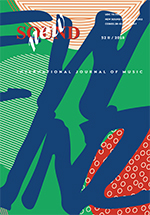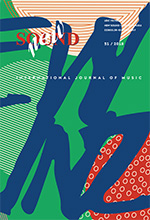Issue No. 38
Composer Speaks
Valentina Radoman – FROM MINIMALISM TO CLASSICISM: A COMPOSER'S JOURNEY. Interview with Miloš Raičković
Download: ser / eng
Core Issue
Iva Nenić – INNER/OUTER BORDERLAND: CONTEMPORARY 'REWORKING' OF GUSLE
Abstract: The traditional music of Serbian gusle underwent significant changes in the last two decades, the major one being the verve that took place inwardly inside local traditional culture of gusle playing. However, there are also instances of outward changes, brought by gusle’s placement in ’international’ musical contexts where this instrument has been recently introduced. In this paper I shall analyze two recent works by Serbian composers Milica Paranosić and Aleksandra Vrebalov where gusle are featured: Morrigan’s Song by former and ...hold me, neighbor, in this storm... by latter. Although the ideology, genres and stylistic features of these works differ, they hold in common a specific manner in which the instrument and its distinctive sound is both ‘exoticised’ and deconstructed. I will argue that both works challenge the familiar notions of ‘being-at-home’ and ‘standing somewhere else’ and thus articulate alternate identity spaces, achieving this through the act of symbolic re-inscription of gusle’s sound, appearance and function.
Keywords: gusle, contemporary music, identity, multiculturalism in music, gender.
Download: ser / eng
Mirjana Veselinović-Hofman – MUSIC AT THE PERIPHERY UNDER CONDITIONS
OF DEGRADED HIERARCHY BETWEEN THE CENTRE AND THE MARGINS IN THE SPACE OF
THE INTERNET
Abstract: This paper deals with the emergence of a new kind of music of the centre and music of the margins, by means of the deconstruction of the ‘old’, historically and profes- sionally founded and economically-politically enabled establishment of a hierarchical re- lation between the centre and the margins in the world of music. This deconstruction is here interpreted as a phenomenon initiated by the actions of the music industry, and is an immediate result of the expansion of the Internet, its meta-media and market logic. The newly emergent type of seniority between the central and the peripheral is perceived as currently highly important for the affirmation of peripheral musical cultures and their over- coming the status of marginal. Because their belonging to the new type of centre mostly depends literally on themselves and their relevant initiatives, without the psychologica socio-economical or political burden which is otherwise implied by the implanted aware- ness of belonging both to the marginal and the mainstream cultures within the ‘old’ hier- archy.
Keywords: centre, periphery, hierarchy, music industry, deconstruction, Internet.
Download: ser / eng
Virginia Anderson – JOHN WHITE AND THE ALTERNATIVE BRITISH EXPERIMENTAL AESTHETIC
Abstract: This paper proposes that the British experimental movement, considered to be ‘fringe’ to a notional central tradition, is actually the centre of an entirely different tradition in contemporary music. The sonatas and minimalist compositions by the composer John White (1936), rather than the notational experiments of his more famous contemporary Cornelius Cardew, reveal aspects of this alternative experimental and postmodern centre.
Keywords: John White, experimentalism, minimalism, systems, Machines, piano sonatas, ‘avant postmodernism’, alternative history.
Download: ser / eng
Sophie Stévance – CONTEMPORARY MUSIC AT THE FRINGE: THE EXAMPLE OF “MUSIQUE ACTUELLE” IN CANADA
Abstract: The International Week of Today’s Music (SIMA), organised in 1961 by Pierre Mercure within the framework of the Montreal Festivals, is a master event: beside the works of Serge Garant, Karlheinz Stockhausen or Iannis Xenakis, this event permitted to the experimental music of today to be heard as provocative and heterogeneous as it may be, in particular with Cage Atlas Eclipticalis’ creation or Richard Maxfield’s Piano Concert for David Tudor. Mercure challenged an American experimental aesthetic’s different from Europeans experimentations. The hypothesis of this paper is that what has been called “musique actuelle” since 1979 in Quebec, refers to Mercure’s artistic perspectives. How affiliated is musique actuelle to the SIMA? This paper seeks to answer this question by looking at the different uses of the expression of musique actuelle so as to bring to light the historical reasons, roots and fundaments of the expression since its first uses. The ac- tualist movement has in common with Mercure’s project more than a name: it carries and maybe focuses for the Mercure’s aesthetic and social policy by refusing certain zone sys- tem within cultural poles with creation methods such as free and collective improvisation. But beyond this project, it’s definitely of Mercure event’s tradition that actualists arose and built their identity field.
Keywords: Musique actuelle, actualism, Pierre Mercure, Productions SuperMusique, mu- sical identity, The International Week of Today’s Music.
Download: ser / eng
New Works
Jelena Novak – POLITICS OF SADNESS: LITTLE FLOWER, REFRIGERATOR LORRY, DEATH AND SYMPHONIC TRADITION
Abstract: Marko Nikodijević’s composition “cvetić, kućica.../la lugubre gondola: funeral music after franz liszt – in memoriam” (2009) is one of the intriguing examples of ques- tioning music for orchestra and the problematization of its status today. The first part of the text offers some guide marks for contextualizing the piece from the composer’s words in and about the score. The second part of the text traces particular compositional proce- dures and the relationship with Liszt’s piece used as a palimpsest that might reveal mean- ings significant for understanding of Nikodijević’s music, and offers conclusions about his and his piece’s daring political, professional and artistic statements.
Keywords: Marko Nikodijević, symphonic music, funeral music, Franz Liszt, palimpsest.
Download: ser / eng
Interpretations
Lauren Redhead – RE-PERFORMING THE MATERIAL AND NARRATIVE OF THE POST-WAR AVANT-GARDE
Abstract: Contemporary music which does not fit into the narrative of the post-war avant- garde, but which can be said to belong to the same tradition, is often marginalised by this movement. Through an analysis of the implications of an understanding of material in the context of the avant-garde, and a short investigation into the music of Chris Newman, the validity of the term avant-garde and the use of narrative are critiqued with respect to the exclusion of composers from the forefront of contemporary music practice.
Keywords: Contemporary Music, Darmstadt School, Myth, Twentieth Century Canon, Chris Newman.
Download: ser / eng
Analyses
Michael Austin – A CASE STUDY IN ANALYZING MUSICAL MULTIMEDIA USING UNITÉS SÉMIOTIQUES TEMPORELLES
Download: ser / eng
Festivals and Symposia
Radmila Milinković – Conference of International Association of Music Libraries, Archives and Documentation Centres Dublin, 24–30 July 2011
Download: ser / eng
Reviews
Ira Prodanov Krajišnik – Section for Musicology and Ethnomusicology Historija muzike u Bosni i Hercegovini [History of Music in Bosnia and Herzegovina], by Ivan Čavlović Sarajevo, 2011, Univerzitet u Sarajevu, Muzička akademija u Sarajevu, Institut za muzikologiju, 388 pages
Download: ser / eng
Ira Prodanov Krajišnik – Mark Fori: Saglasje tradicije i kulture u tamburaškoj muzici Vojvodine [Mark Forry: The Mediation of ‘Tradition’ and ‘Culture’ in the Tamburitza Music of Vojvodina/ Yugoslavia], trans. Dušan Brankov and Angelina Čanković Popović, Novi Sad, Prometej, 2011, 322 p.
Download: ser / eng
Biljana Srećković – Vladan Radovanović Fonoverzum – elektroakustička muzika [Phonoverse – Electroacoustic Music], Sokoj, 2010
Download: ser / eng


